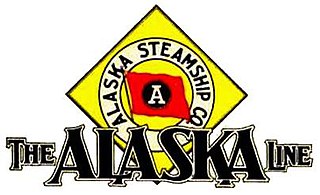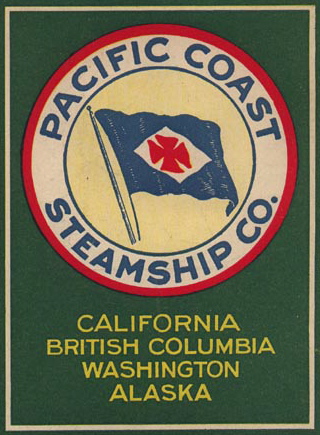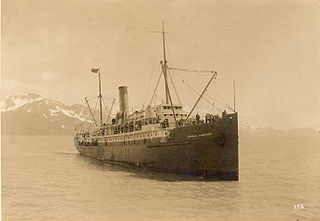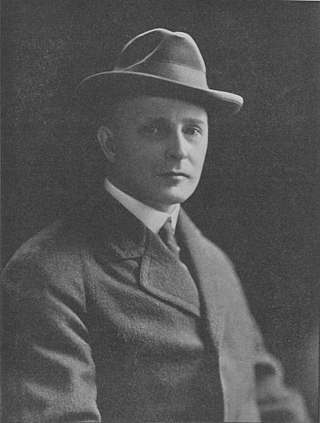Related Research Articles

The Puget Sound Navigation Company (PSNC) was founded by Charles E. Peabody in 1898. Today the company operates an international passenger and vehicle ferry service between Port Angeles, Washington, United States and Victoria, British Columbia, Canada on the MV Coho, through its operating company, Black Ball Ferry Line.

The steamboat Monticello (2) operated in the early 1900s as part of the Puget Sound Mosquito Fleet. The vessel went through several reconstructions and remained in service until 1962, when she was lost in Alaska waters. Her later names were Penaco and Sea Venture. (This Puget Sound steamer should not be confused with the smaller Monticello, which also ran on Puget Sound, but was built in 1895 for Captain Z.J. Hatch of the Monticello Steamship Company.

Olympian was a large side-wheel inland steamship that operated in the Pacific Northwest and Alaska. Olympian operated from early 1884 to late 1891 on the Columbia River, Puget Sound, and the Inside Passage of British Columbia and Alaska.

The steamboat Rosalie operated from 1893 to 1918 as part of the Puget Sound Mosquito Fleet, also operating out of Victoria, B.C. In 1898, Rosalie went north with many other Puget Sound steamboats to join the Klondike Gold Rush.

The sidewheeler Idaho was a steamboat that ran on the Columbia River and Puget Sound from 1860 to 1898. There is some confusion as to the origins of the name; many historians have proposed it is the inspiration for the name of the State of Idaho. Considerable doubt has been cast on this due to the fact that it is unclear if the boat was named before or after the idea of 'Idaho' as a territory name was proposed. John Ruckel also allegedly stated he had named the boat after a Native American term meaning 'Gem of the Mountains' he got from a mining friend from what is now Colorado territory. This steamer should not be confused with the many other vessels of the same name, including the sternwheeler Idaho built in 1903 for service on Lake Coeur d'Alene and the steamship Idaho of the Pacific Coast Steamship Line which sank near Port Townsend, Washington.

The Alaska Steamship Company was formed on August 3, 1894. While it originally set out to ship passengers and fishing products, the Alaska Steamship Company began shipping mining equipment, dog sleds, and cattle at the outbreak of the Klondike Gold Rush of 1897. The company was purchased by the Alaska Syndicate and merged with the Northwestern Steamship Company in 1909, but retained its name, and the fleet was expanded to 18 ships. During World War II, the government took over the company's ships. When the war ended, the company struggled to compete with the new Alaska Highway for passengers and freight. It discontinued passenger service altogether in 1954 and shut down operations in 1971.

Joshua Green was an American sternwheeler captain, businessman, and banker. He rose from being a seaman to being the dominant figure of the Puget Sound Mosquito Fleet, then sold out his interests and became a banker. Living to the age of 105 and active in business almost to the end of his life, he became an invaluable source of information about the history of Seattle and the Puget Sound region. According to Nard Jones, Green was one of the city of Seattle's last fluent speakers of Chinook Jargon, the pidgin trade language of the Pacific Northwest.

Hyak was a wooden-hulled steamship that operated on Puget Sound from 1909 to 1941. This vessel should not be confused with the sternwheeler Hyak which ran on the extreme upper reach of the Columbia River at about the same time. The name means "swift" or "fast" in the Chinook Jargon.

Richard Holyoke was a seagoing steam tug boat built in 1877 in Seattle, Washington and which was in service on Puget Sound and other areas of the northwest Pacific coast until 1935. The vessel was considered to be one of the most powerful tugs of its time.

Dode was a steamboat that ran on Hood Canal and Puget Sound from 1898 to 1900.

General Miles was a steamship constructed in 1882 which served in various coastal areas of the states of Oregon and Washington, as well as British Columbia and the territory of Alaska. It was apparently named after US General Nelson A. Miles.

The Pacific Coast Steamship Company was an important early shipping company that operated steamships on the west coast of North America. It was first organized in 1867 under the name Goodall, Nelson and Perkins. The Goodall, Nelson & Perkins Steamship Company was formed in 1875, but a year later was reorganized as the Pacific Coast Steamship Company. In 1916 the Admiral Line bought the shipping interests of the company.

Sol Duc was a steamship which was operated on northern Puget Sound from 1912 to 1935, chiefly on a route connecting ports on the Olympic Peninsula with Seattle. During the Second World War (1941–1945) Sol Duc served as a barracks ship.

Princess Beatrice was a steamship built for and owned by the marine division of the Canadian Pacific Railway (CPR). The ship served from 1903 to 1928 in the coastal waters of British Columbia. The ship also operated on Puget Sound on a route from Victoria, British Columbia to Seattle, Washington. Princess Beatrice was the first ship to operate in the year-round steamship service between Seattle and Victoria that was run by CPR from 1904 to 1959. This ship should not be confused with an earlier Princess Beatrice, built in Scotland in 1874, which served on the Atlantic coast of Canada.
The Pacific-Alaska Navigation Company was an American passenger and freight ocean shipping company that operated between 1912 and 1916 on the West Coast of North America. It was formed as a holding company during the merger of the Alaska Pacific Steamship Company and the Alaska Coast Company. During its four years of life, its fleet became known as the Admiral Line because its ships were usually named for former U.S. Navy admirals. The company was operated by president H.F. "Bert" Alexander, a former Tacoma longshoreman who worked his way up the ranks.

The SS Admiral Sampson was a U.S.-flagged cargo and passenger steamship that served three owners between 1898 and 1914, when it was rammed by a Canadian passenger liner and sank in Puget Sound. Following its sinking off Point No Point, the Admiral Sampson has become a notable scuba diving destination for advanced recreational divers certified to use rebreathing equipment.

The steamship General Frisbie was a wooden two-deck passenger ship built in 1900, named after John B. Frisbie. She was designed for use as a ferry between Vallejo and San Francisco. The steamer was successful in that role and was the fastest ship on the route when she began service. Improved roads, bridges, and automobiles reduced demand for ferry service in the Bay Area, and newer ships were optimized for transporting cars, so General Frisbie was retired in the late 1920s.

The City of Seattle was a passenger steamship built in 1890 in Philadelphia, Pennsylvania. The City of Seattle operated out of Puget Sound from 1890 to 1921, during which it ran routes between the local ports as well as Alaska, notably transporting prospectors during the Klondike Gold Rush. In 1921, the City of Seattle returned to the East Coast where it ran routes in both New York and Florida. In 1937, the City of Seattle returned to Philadelphia to be scrapped.
Northland Transportation Company operated cargo and passenger ships from Seattle to Southeast Alaska starting in 1923. During World War II Northland Transportation Company was active in charter shipping with the Maritime Commission and War Shipping Administration. Northland Transportation Company, proposed a loan from United States Shipping Board to build a ship for Puget Sound-Alaska trade in 1933. In 1934, the company was granted a $350,000 loan to build a new ship. The 1,400 tons passenger ship, was built at Lake Washington Shipyard in Houghton, Washington. Northland Transportation Company Seattle dock and warehouse were at Pier 56, now Ainsworth and Dunn Wharf.

Frank Waterhouse was an English-born, American-based businessman, a prominent figure in the shipping industry in the early 20th century. He was also president of the Seattle Chamber of Commerce and of two Seattle taxi companies. His New York Times obituary described him as having had "one of the most colorful careers in the history of the Pacific Northwest."
References
- ↑ Tuttle, Charles R. (1914). Alaska: Its Meaning to the World, Its Resources, Its Opportunities. Seattle: F. Shuey & Co. p. 289. OCLC 1838234.
- ↑ Alexander, Joshua W.; Solomon S. Huebner (1914). Proceedings of the Committee on the Merchant Marine and Fisheries in the Investigation of Shipping Combinations under House Resolution 587. Washington, D.C.: Government Printing Office. p. 352. OCLC 6242269.